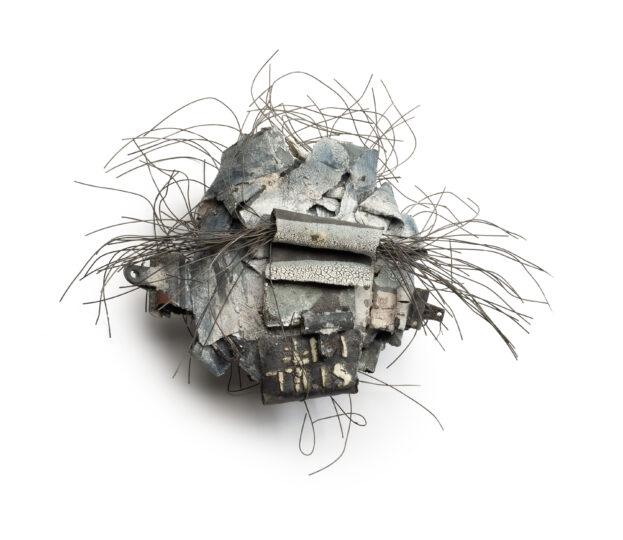15/03/24
Gillian Lowndes: Radical Clay
Holburne Museum, Bath
26 January – 21 April 2024
I didn’t know what to expect when I was commissioned to review this exhibition, as I hadn’t heard of Gillian Lowndes (1936-2010). Nevertheless, I was curious to find out more about this bricoleuse, and it turned out to be one of those treasures of a gallery visit, when I am met with something completely surprising, absorbing and inspiring, unsullied enough by criticism that I am free to let my mind loose to play with interpretations.
Hettie Judah got there before me, with the headline of her review in the Guardian labelling the exhibition “rude, punky and downright diabolical”. I am afraid I don’t agree. This bijou exhibition – one small room, painted white, with seven wall-mounted works, and a vitrine outside in the atrium, containing a further four, small-scale pieces – certainly stands in stark contrast to the general mood and style of the venue, but it is like entering a time capsule, a bubble separated from the wider museum by a thin veil of laboratory-bright light, and filled with broken, eroded, post-apocalyptic artefacts, all seemingly long since abandoned. Lowndes’s Hook Figure series (1990s onwards, with two pieces from 2008 included here), for example, call to mind the flotsam and jetsam washed in with the tide and bleached by the sun – items you might pick up from the beach with curiosity, only to fling them away in disgust when the texture is not as expected. Indeed, seeking “to make work that looked fibrous in ceramics”, Lowndes came up with the idea of slicing up loofahs – along with cones, metal clips, electrical wires and plant roots – and dipping them in slip before firing them in a kiln. The process created forms of fossil. Likewise, Hanging Scroll (1995), which comprises multilayered, roughly cylindrical forms, interspersed with floorboard nails, seems cleaned and carefully preserved, but as if it might disintegrate were the nails to be removed.

Lowndes described herself as a “materials-driven artist” and a “gatherer of impedimenta”, creating works that were “material-based objects, not pre-planned objects”. While loth to define her practice too restrictively – “I want to make what I want to make, I have an idea and I want to make an idea” – she concedes: “I’ve often called myself a ceramicist because I work in a kiln, but I’m probably a sculptor more than anything else.” As a student in the 1950s at the Central School of Arts and Crafts in London, Lowndes in fact transferred from the sculpture department – which she found “quite basic, easygoing [but] lacking in vision” – to the pottery department, where she discovered the limitless boundaries of working with clay. While, from the outset, Lowndes was concerned with investigations of material, process and transformation, using coiling, slabbing and press-moulding techniques, it was an 18-month stay in Nigeria, in the early 70s, with her partner, the fellow-potter Ian Auld, and their toddler, Ben, that opened her eyes to the possibilities of combining different – frequently “found” – materials in a single artefact. It was from this experience that the bricoleuse – or, as she described herself, “a general maker of materials” – was born.
Read my full review here